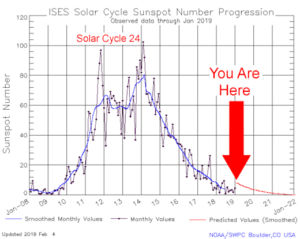by D. Archibald, Aug 28, 2024 in TheWentworthReport
This review was prepared for a Zoom interview on the Sun’s role in climate. Some say carbon dioxide is the controlling variable in climate. That notion is discredited, most recently by a study on variation in the Earth’s albedo. As the following figure from that study shows, all of the atmosphere’s temperature rise this century mirrors the reduction in albedo with no room for a contribution from carbon dioxide:
…
This is consistent with the logarithmic heating effect of carbon dioxide. Half of the warming from atmospheric carbon dioxide comes from the first 20 ppm and then rapidly drops away from there. Carbon dioxide is tuckered out as a greenhouse gas:

From the current 423 ppm, each 100 ppm increase results in a temperature rise of only 0.1°C. The atmosphere will only get to about 600 ppm before we run out of rocks we can dig up and burn. So the warming effect from carbon dioxide is only good for another 0.2°C. There is no human on our planet sensitive enough to feel a 0.2°C difference in temperature. And this story doesn’t have a happy ending. There is 50 times as much carbon dioxide in the oceans than in the atmosphere, so the 800-year turnover of the oceans will take 98% of the carbon dioxide humans have added to the atmosphere down to the Davy Deep and we won’t see it again. A couple of hundred years from now our descendants will be lamenting the annual decline in crop yields due to falling carbon dioxide levels.
…
by Cap Allon, Apr 30, 2021 in Electroverse
GALACTIC Cosmic Rays are a mixture of high-energy photons and sub-atomic particles accelerated toward Earth by supernova explosions and other violent events in the cosmos, while SOLAR Cosmic Rays are effectively the same, only their source is the Sun.
Spaceweather.com and the students of Earth to Sky Calculus have been launching cosmic ray balloons almost weekly since March 2015–before the pandemic threw a spanner in. The team’s published results reveal that atmospheric radiation reached record highs just as solar activity hit a new space age low — the correlation is clear for all to see, with additional proxy data revealing it has been the case for time-immemorial.
During solar minimums –the low point of the 11 year solar cycle– the Sun’s magnetic field weakens and the outward pressure of the solar wind decreases. This allows more cosmic rays (CRs) to penetrate the inner solar system, including our planet’s atmosphere:

Cosmic Rays correlating with Sunspots.
…
by Dr Tony Phillips, March 6, 2019 in SpaceWeatherArchive
March 1, 2019: There are 28 days in February. This year, all 28 of them were spotless. The sun had no sunspots for the entire month of Feb. 2019. This is how the solar disk looked every day:
…

How does this affect us on Earth? The biggest change may be cosmic rays. High energy particles from deep space penetrate the inner solar system with greater ease during periods of low solar activity. Indeed, NASA spacecraft and space weather balloons are detecting just such an increase in radiation. Cosmic rays can alter the flow of electricity through Earth’s atmosphere, trigger lightning, potentially alter cloud cover, and dose commercial air travelers with extra “rads on a plane.”
As February ended, March is beginning … with no sunspots. Welcome to Solar Minimum!
La géologie, une science plus que passionnante … et diverse



